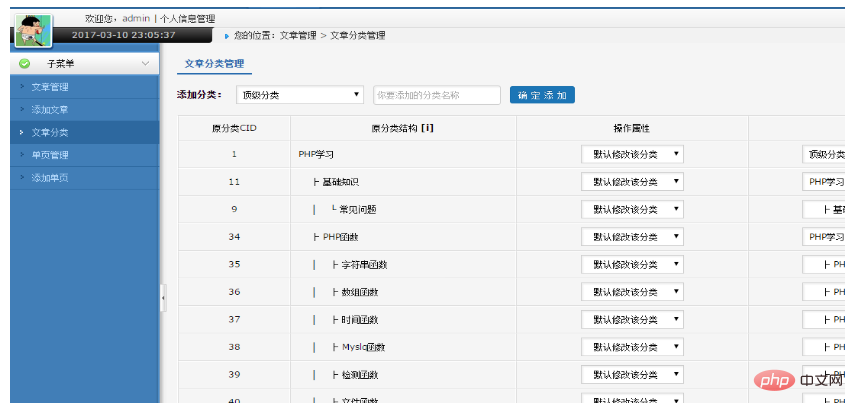

Bibliothèque de catégories classifications illimitées
Voici comment utiliser cette bibliothèque de classes
include("Common/Category.class.php");
$Category = new Category("ArticleCategory",array('id','pid','name','fullname'));
$categoryList = $Category->getList();
1. Incluez la bibliothèque de classes via include
2. Instanciez la classe via new
3. Appelez la méthode getList() pour obtenir toutes les listes de catégories
4. Retournez : toutes les listes de catégories, vous pouvez afficher la référence en obtenant le nom complet.
L'effet est le suivant :

Ce qui suit est le code source complet de la bibliothèque de classes :
<?php
/**
* 类功能:php无限分类
* author:252588119@qq.com
* 使用方法见:http://liqingbo.cn/blog-434.html
*/
class Category {
private $model; //分类的数据表模型
private $rawList = array(); //原始的分类数据
private $formatList = array(); //格式化后的分类
private $error = ""; //错误信息
private $icon = array(' │', ' ├ ', ' └ '); //格式化的字符
private $fields = array(); //字段映射,分类id,上级分类pid,分类名称name,格式化后分类名称fullname
/**
* 构造函数,对象初始化
* @param array,object $model 数组或对象,基于TP3.0的数据表模型名称,若不采用TP,可传递空值。
* @param array $field 字段映射,分类cid,上级分类pid,分类名称,格式化后分类名称fullname
*/
public function __construct($model = '', $fields = array()) {
if (is_string($model) && (!empty($model))) {
if (!$this->model = D($model))
$this->error = $model . "模型不存在!";
}
if (is_object($model))
$this->model = &$model;
$this->fields['cid'] = $fields['0'] ? $fields['0'] : 'id';
$this->fields['pid'] = $fields['1'] ? $fields['1'] : 'pid';
$this->fields['name'] = $fields['2'] ? $fields['2'] : 'name';
$this->fields['fullname'] = $fields['3'] ? $fields['3'] : 'fullname';
}
/**
* 获取分类信息数据
* @param array,string $condition 查询条件
* @param string $orderby 排序
*/
private function _findAllCat($condition, $orderby = NuLL) {
$this->rawList = $this->model->where($condition)->order($orderby)->select();
}
/**
* 返回给定上级分类$pid的所有同一级子分类
* @param int $pid 传入要查询的pid
* @return array 返回结构信息
*/
public function getChild($pid) {
$childs = array();
foreach ($this->rawList as $Category) {
if ($Category[$this->fields['pid']] == $pid){
$childs[] = $Category;
}
}
return $childs;
}
/**
* 递归格式化分类前的字符
* @param int $cid 分类cid
* @param string $space
*/
private function _searchList($cid = 0, $space = "") {
$childs = $this->getChild($cid);
//下级分类的数组
//如果没下级分类,结束递归
if (!($n = count($childs))){
return;
}
$m = 1;
//循环所有的下级分类
for ($i = 0; $i < $n; $i++) {
$pre = "";
$pad = "";
if ($n == $m) {
$pre = $this->icon[2];
} else {
$pre = $this->icon[1];
$pad = $space ? $this->icon[0] : "";
}
$childs[$i][$this->fields['fullname']] = ($space ? $space . $pre : "") . $childs[$i][$this->fields['name']];
$this->formatList[] = $childs[$i];
$this->_searchList($childs[$i][$this->fields['cid']], $space . $pad . " "); //递归下一级分类
$m++;
}
}
/**
* 不采用数据模型时,可以从外部传递数据,得到递归格式化分类
* @param array,string $condition 条件
* @param int $cid 起始分类
* @param string $orderby 排序
* @return array 返回结构信息
*/
public function getList($condition = NuLL, $cid = 0, $orderby = NuLL) {
unset($this->rawList, $this->formatList);
$this->_findAllCat($condition, $orderby);
$this->_searchList($cid);
return $this->formatList;
}
/**
* 获取结构
* @param array $data 二维数组数据
* @param int $cid 起始分类
* @return array 递归格式化分类数组
*/
public function getTree($data, $cid = 0) {
unset($this->rawList, $this->formatList);
$this->rawList = $data;
$this->_searchList($cid);
return $this->formatList;
}
/**
* 获取错误信息
* @return string 错误信息字符串
*/
public function getError() {
return $this->error;
}
/**
* 检查分类参数$cid,是否为空
* @param int $cid 起始分类
* @return boolean 递归格式化分类数组
*/
private function _checkCatID($cid) {
if (intval($cid)) {
return true;
} else {
$this->error = "参数分类ID为空或者无效!";
return false;
}
}
/**
* 检查分类参数$cid,是否为空
* @param int $cid 分类cid
*/
private function _searchPath($cid) {
//检查参数
if (!$this->_checkCatID($cid))
return false;
$rs = $this->model->find($cid); //初始化对象,查找上级Id;
$this->formatList[] = $rs; //保存结果
$this->_searchPath($rs[$this->fields['pid']]);
}
/**
* 查询给定分类cid的路径
* @param int $cid 分类cid
* @return array 数组
*/
public function getPath($cid) {
unset($this->rawList, $this->formatList);
$this->_searchPath($cid); //查询分类路径
return array_reverse($this->formatList);
}
/**
* 添加分类
* @param array $data 一维数组,要添加的数据,$data需要包含上级分类ID。
* @return boolean 添加成功,返回相应的分类ID,添加失败,返回FALSE;
*/
public function add($data) {
if (empty($data))
return false;
return $this->model->data($data)->add();
}
/**
* 修改分类
* @param array $data 一维数组,$data需要包含要修改的分类cid。
* @return boolean 组修改成功,返回相应的分类ID,修改失败,返回FALSE;
*/
public function edit($data) {
if (empty($data))
return false;
return $this->model->data($data)->save();
}
/**
* 删除分类
* @param int $cid 分类cid
* @return boolean 删除成功,返回相应的分类ID,删除失败,返回FALSE
*/
public function del($cid) {
$cid = intval($cid);
if (empty($cid))
return false;
$conditon[$this->fields['cid']] = $cid;
return $this->model->where($conditon)->delete();
}
/**
* 删除分类
* @param int $cid 分类cid
* @return boolean 删除成功,返回相应的分类ID及所有子ID 数组,返回FALSE
*/
public function getIdArr($cid){
$cid = !empty($cid) ? intval($cid) : 0;
if (empty($cid)) return false;
$list = $this->getList($condition = NuLL,$cid, $orderby = NuLL);
foreach($list as $val){
$idArr[] = $val[$this->fields['cid']];
}
unset($list);
$idArr[] = $cid;
return $idArr;
}
}
?>
La démo contient un dossier de fichiers, trois fichiers. Le dossier Helper contient des classes de traitement de classification illimitées. Le dossier est placé dans le répertoire Application/Common/. CategoryController.class.php est le fichier du contrôleur. Il est utilisé pour montrer comment utiliser une classification illimitée. contrôleur, n'oubliez pas d'introduire l'utilisation en premier. CommonHelperCategory;category_add.html est un fichier de vue utilisé pour montrer comment appeler des catégories illimitées dans le modèle.
go_category.sql est un fichier de base de données de table de classification, pour référence uniquement. Les champs principaux de la table de classification sont id : identifiant de colonne, titre : nom de colonne, parent_id : identifiant de colonne parent, is_show : s'il faut afficher dans au premier plan, trier : tri frontal.
Ce qui précède est le contenu détaillé de. pour plus d'informations, suivez d'autres articles connexes sur le site Web de PHP en chinois!
 Comment utiliser le code js
Comment utiliser le code js
 Utilisation de la commande de recherche Linux
Utilisation de la commande de recherche Linux
 Algorithme de remplacement de page
Algorithme de remplacement de page
 Comment ouvrir le fichier bak
Comment ouvrir le fichier bak
 Top 30 des monnaies numériques mondiales
Top 30 des monnaies numériques mondiales
 Quel équipement est nécessaire pour la diffusion en direct de Douyin ?
Quel équipement est nécessaire pour la diffusion en direct de Douyin ?
 fichiers communs
fichiers communs
 Comment utiliser le paramètre Oracle
Comment utiliser le paramètre Oracle